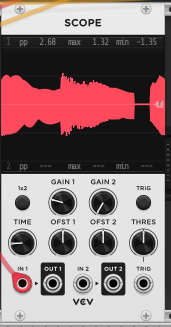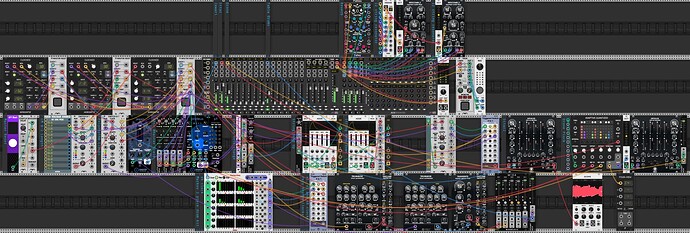And to be sure, I would like to see more in this evolution. I’m just taking a pause from this for unrelated personal issues… at least for a few days’ sanity break. I need to redo all of my raga patches except for this last one for the same personal reason.
This is a really cool patch Ken, sounds real to me.
Thanks. I have an even better sound as of this morning that I need to record and post. Actually, the sound generation techniques remain the same, but the string bends up and down as well as holding tied notes really sounds good at 30 BPM, even as a solo without Jawari and drone or even tabla.
Uh … TLDR (the image), but is there any feature that dampens any of the “plucked” notes? I’m thinking that on a real sitar, any note played on a given string that is followed by a different note on the same string would be immediately muted, while the sympathetic strings it triggered keep going.
Sounds pretty close though. ![]()
Yeah, in fact, while the sitar has many strings, you only play the melody on one string (with a few exceptions; some of the very bass notes can be played on one of the droning strings). The other strings are strummed for drone/background or for rhythm.
I would love to see a sitar module in your plugin. All I can do is create sounds that remind me of what I have heard on sitar. I used to do the same thing in the mid 70s on my banjo. I played it to sound like sitar raga scales.
That is a very good point. Currently I use the BGA ASSIGN module to let multiple (2) melody notes ring out as I have the channel count set to 2. I will change my patch to 1 channel and see how that sounds. Not sure why I did not think of that. Thanks for the question.
And thanks for the thumbs-up ![]()
Yup, that could be a fun (but challenging!) project. Banjo is not a bad substitute though, does have something of the twanginess.
Something that just occurred to me is that once you get the sympathetic vs. plucked strings worked out, it might not be too much of a stretch to adapt it to a Hardingfele or Hardanger fiddle.
It has 4 bowed (or plucked) strings, plus a course of 4 or 5 sympathetic strings that run under the fingerboard.

It a more subtle effect than the sitar’s drones.
A Hardanger fiddle was also featured in the “Rohan theme” in Lord of the Rings: The Two Towers.
Ah. ASSIGN along with Count Modula’s POLY GATE MODIFIER are an indispensable pair for me, typically set to 4 channels.
For the damping feature, wouldn’t it be nice to have a retro-active envelope to damp it, rather than simply chopping it off? ![]() It needs a Time Machine module. Or a clever application of trigger delays.
It needs a Time Machine module. Or a clever application of trigger delays.
I will take a look at it. I do some similar things for doing string bends (pitch) that I could do with amplitude. Good suggestion. Thanks. Also, I want to look at what I can do within Vult Opulus. It has 2 ADSR’s internally. I have not spend too much time and don’t remember how I chose the ADSR settings, or if I just used the Opulus Sitar2 preset default settings. Currently the release is set to a longer time rather than shorter.
Edit: adding a Scope in shows the story clearly.

Did you have a specific technique in mind for this? I’m not sure how a retroactive envelope could be applied unless there was a long delay buffer that could be messed with.
Here is my latest Sitar, Jawari, plucked drone and tabla patch. This version includes reduction in melody notes overlap ringing as well as string bends up and down and hold on tied notes. Let me know what you think about the string bends. String bends are a very important part of the sitar sound and the bends are much larger than on a guitar. Do you think the bends add to this piece or detract from it?
Bends are very difficult for me to emulate in Rack. I spent quite a bit of time trying to develop electric guitar string bends a couple of years ago. I was never totally happy with my results.
Slow articulated sitar with Hold on Tied Notes and String Bends-1.vcv (14.6 KB)
I think that part of the reason for this is that I have the sitar emulation melodic string pitch range going too low.
If you were to list one thing that distinguishes the sitar raga sound from similar instruments and styles, what would that thing be? Or, a few things ![]()
BTW, back in the 70s, my favorite way to play my electric guitar was to emulate the sitar raga style. This usually involved flat picking the strings closer to the bridge for harmonics and fretting about halfway down the neck. I tended to limit my playing to 2-3 strings,staying within a “box”, rather than running up and down a single melody string. I played the banjo “sitar” in a similar manner.
Much of the complex behaviour of the Sitar is determined by the stretching, plucking and resonating of the strings, interacting with each other and the rest of the construction (bridges/resonator). And of course the interaction with the player…
There has (of course) been all sorts of research on how to emulate a Sitar. And, as suggested earlier, Physical Modeling seems the way to go. Specifically using Karplus Strong (which is good at emulating plucked strings) and/or waveguide modeling.
Slight tangent: loads of DSP/Physical Modeling/Waveguide stuff was worked out, described and published (and partly patented) by Julius O Smith III as CCRMA at Standford Univeristy.
The ‘jos’ site is a treasure trove of both practical and deep knowledge on DSP (including all the math). It is also linked to from the VCV Rack Development section. https://ccrma.stanford.edu/~jos/
Anyway,
Below is a link to an example of such a reseach paper (in PDF) on Researchgate going into some of the relevant details. Details that might help you to get closer to a satisfactory emulation using the tools available to you. Or…inspire someone to create/adapt tools (more) dedicated this specific purpose.
Thanks. I downloaded the 69 page PDF file and will give it a read. This thesis appears to be a great resource if someone were to develop a sitar module.
I’m pretty happy with using the Vult OPULUS “sitar2” FM operator preset and the Vult RESCOMB2 resonant comb filter for the sympathetic strings. String bending is a tough problem. The above thesis says they were unsuccessful in modelling string bending in MaxMSP due to unavoidable “distortion”. String bending is a non-linear dynamic system except for very low degrees of bending such that the non-linearities can be ignored. But, the non-linearities in the physical sitar system are real and ultimately have to be dealt with, or faked in some way.
It is a fascinating topic, for sure.
Better is often the enemy of good (enough). Satisfactory is often a more achieveable and in the end satisfactory aim. Even millions of years of evolution tends to stop at ‘good enough’ solutions.
Slight tangent…on good enough…
“BE Smart” on “Evolution FAILS in the Human Body”
Anyway…
As with the Tabla (which could be approximated by adding an extra 2nd dimension to the waveguide model) the Sitar reacts in pretty dramatic ways to the pretty intrusive physical manipulations of playing the thing(s). Very dynamic hitting/plucking, pushing/pulling/bending and dampening.
Even if the actual physical behaviour of the instrument(s) would be modeled to perfection…there is still the problem of interaction/playing via the available interfaces to solve…
But hey, how numbingly dull is a life without challenges?
I have a VCV OCT module in the patch after Proteus. I had lowered the sound by 1 octave, giving the deep surbahar-like bass notes. Returning OCT to the nominal octave and just using Proteus’s octave range sounds more like a sitar. Thanks for catching this.
Can you say anything about the design behind Proteus, regarding the octave range of the output, including the root octave range and the OCTAVE “change probability”? If that is in the manual, remind me and I will re-read it. Thanks.
I am definitely not a perfectionist as, coming from a theoretical physics background, the Heisenberg uncertainty principle prohibits perfection measuring 2 conjugate variables simultaenously:
Conjugate variables - Wikipedia
I am fairly confident that perfection is impossible in any physical system.
So, yes, it always comes down to good enough, if we can define what “good” means. Fortunately, art has a lot of subjective determination for “good” and “good enough”.
On a somewhat different tangent, but related. The non-linearities in real systems introduces harmonic distortions in physical sound, very similar to “aliasing” in discrete sampling systems. And often it is these non-linearity distortions that give an instrument its distinct sound and subjective value of goodness.



